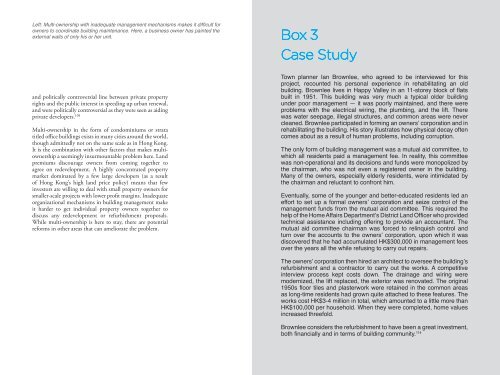Treating the Symptoms - A Critical Review of ... - Civic Exchange
Treating the Symptoms - A Critical Review of ... - Civic Exchange
Treating the Symptoms - A Critical Review of ... - Civic Exchange
- No tags were found...
You also want an ePaper? Increase the reach of your titles
YUMPU automatically turns print PDFs into web optimized ePapers that Google loves.
Left: Multi-ownership with inadequate management mechanisms makes it difficult forowners to coordinate building maintenance. Here, a business owner has painted <strong>the</strong>external walls <strong>of</strong> only his or her unit. Box 3Case Studyand politically controversial line between private propertyrights and <strong>the</strong> public interest in speeding up urban renewal,and were politically controversial as <strong>the</strong>y were seen as aidingprivate developers. 108Multi-ownership in <strong>the</strong> form <strong>of</strong> condominiums or stratatitled <strong>of</strong>fice buildings exists in many cities around <strong>the</strong> world,though admittedly not on <strong>the</strong> same scale as in Hong Kong.It is <strong>the</strong> combination with o<strong>the</strong>r factors that makes multiownershipa seemingly insurmountable problem here. Landpremiums discourage owners from coming toge<strong>the</strong>r toagree on redevelopment. A highly concentrated propertymarket dominated by a few large developers (as a result<strong>of</strong> Hong Kong’s high land price policy) means that fewinvestors are willing to deal with small property owners forsmaller-scale projects with lower pr<strong>of</strong>it margins. Inadequateorganizational mechanisms in building management makeit harder to get individual property owners toge<strong>the</strong>r todiscuss any redevelopment or refurbishment proposals.While multi-ownership is here to stay, <strong>the</strong>re are potentialreforms in o<strong>the</strong>r areas that can ameliorate <strong>the</strong> problem.Town planner Ian Brownlee, who agreed to be interviewed for thisproject, recounted his personal experience in rehabilitating an oldbuilding. Brownlee lives in Happy Valley in an 11-storey block <strong>of</strong> flatsbuilt in 1951. This building was very much a typical older buildingunder poor management — it was poorly maintained, and <strong>the</strong>re wereproblems with <strong>the</strong> electrical wiring, <strong>the</strong> plumbing, and <strong>the</strong> lift. Therewas water seepage, illegal structures, and common areas were nevercleaned. Brownlee participated in forming an owners’ corporation and inrehabilitating <strong>the</strong> building. His story illustrates how physical decay <strong>of</strong>tencomes about as a result <strong>of</strong> human problems, including corruption.The only form <strong>of</strong> building management was a mutual aid committee, towhich all residents paid a management fee. In reality, this committeewas non-operational and its decisions and funds were monopolized by<strong>the</strong> chairman, who was not even a registered owner in <strong>the</strong> building.Many <strong>of</strong> <strong>the</strong> owners, especially elderly residents, were intimidated by<strong>the</strong> chairman and reluctant to confront him.Eventually, some <strong>of</strong> <strong>the</strong> younger and better-educated residents led aneffort to set up a formal owners’ corporation and seize control <strong>of</strong> <strong>the</strong>management funds from <strong>the</strong> mutual aid committee. This required <strong>the</strong>help <strong>of</strong> <strong>the</strong> Home Affairs Department’s District Land Officer who providedtechnical assistance including <strong>of</strong>fering to provide an accountant. Themutual aid committee chairman was forced to relinquish control andturn over <strong>the</strong> accounts to <strong>the</strong> owners’ corporation, upon which it wasdiscovered that he had accumulated HK$300,000 in management feesover <strong>the</strong> years all <strong>the</strong> while refusing to carry out repairs.The owners’ corporation <strong>the</strong>n hired an architect to oversee <strong>the</strong> building’srefurbishment and a contractor to carry out <strong>the</strong> works. A competitiveinterview process kept costs down. The drainage and wiring weremodernized, <strong>the</strong> lift replaced, <strong>the</strong> exterior was renovated. The original1950s floor tiles and plasterwork were retained in <strong>the</strong> common areasas long-time residents had grown quite attached to <strong>the</strong>se features. Theworks cost HK$3-4 million in total, which amounted to a little more thanHK$100,000 per household. When <strong>the</strong>y were completed, home valuesincreased threefold.Brownlee considers <strong>the</strong> refurbishment to have been a great investment,both financially and in terms <strong>of</strong> building community. 11431
















